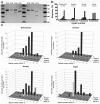Binding of human milk to pathogen receptor DC-SIGN varies with bile salt-stimulated lipase (BSSL) gene polymorphism
- PMID: 21386960
- PMCID: PMC3046167
- DOI: 10.1371/journal.pone.0017316
Binding of human milk to pathogen receptor DC-SIGN varies with bile salt-stimulated lipase (BSSL) gene polymorphism
Abstract
Objective: Dendritic cells bind an array of antigens and DC-SIGN has been postulated to act as a receptor for mucosal pathogen transmission. Bile salt-stimulated lipase (BSSL) from human milk potently binds DC-SIGN and blocks DC-SIGN mediated trans-infection of CD4(+) T-lymphocytes with HIV-1. Objective was to study variation in DC-SIGN binding properties and the relation between DC-SIGN binding capacity of milk and BSSL gene polymorphisms.
Study design: ELISA and PCR were used to study DC-SIGN binding properties and BSSL exon 11 size variation for human milk derived from 269 different mothers distributed over 4 geographical regions.
Results: DC-SIGN binding properties were highly variable for milks derived from different mothers and between samplings from different geographical regions. Differences in DC-SIGN binding were correlated with a genetic polymorphism in BSSL which is related to the number of 11 amino acid repeats at the C-terminus of the protein.
Conclusion: The observed variation in DC-SIGN binding properties among milk samples may have implications for the risk of mucosal transmission of pathogens during breastfeeding.
Conflict of interest statement
Figures




Similar articles
-
HIV-1 disease progression is associated with bile-salt stimulated lipase (BSSL) gene polymorphism.PLoS One. 2012;7(3):e32534. doi: 10.1371/journal.pone.0032534. Epub 2012 Mar 6. PLoS One. 2012. PMID: 22412885 Free PMC article.
-
Bile salt-stimulated lipase from human milk binds DC-SIGN and inhibits human immunodeficiency virus type 1 transfer to CD4+ T cells.Antimicrob Agents Chemother. 2006 Oct;50(10):3367-74. doi: 10.1128/AAC.00593-06. Antimicrob Agents Chemother. 2006. PMID: 17005819 Free PMC article.
-
Lewis X component in human milk binds DC-SIGN and inhibits HIV-1 transfer to CD4+ T lymphocytes.J Clin Invest. 2005 Nov;115(11):3256-64. doi: 10.1172/JCI25105. Epub 2005 Oct 20. J Clin Invest. 2005. PMID: 16239964 Free PMC article.
-
Role of DC-SIGN and L-SIGN receptors in HIV-1 vertical transmission.Hum Immunol. 2011 Apr;72(4):305-11. doi: 10.1016/j.humimm.2011.01.012. Epub 2011 Jan 26. Hum Immunol. 2011. PMID: 21277928 Free PMC article. Review.
-
Human milk bile salt-stimulated lipase: functional and molecular aspects.J Pediatr. 1994 Nov;125(5 Pt 2):S56-61. doi: 10.1016/s0022-3476(06)80737-7. J Pediatr. 1994. PMID: 7965454 Review.
Cited by
-
Colorectal mucus binds DC-SIGN and inhibits HIV-1 trans-infection of CD4+ T-lymphocytes.PLoS One. 2015 Mar 20;10(3):e0122020. doi: 10.1371/journal.pone.0122020. eCollection 2015. PLoS One. 2015. PMID: 25793526 Free PMC article.
-
Effects of bile salt-stimulated lipase on blood cells and associations with disease activity in human inflammatory joint disorders.PLoS One. 2023 Aug 11;18(8):e0289980. doi: 10.1371/journal.pone.0289980. eCollection 2023. PLoS One. 2023. PMID: 37566600 Free PMC article.
-
Breast Milk of HIV-Positive Mothers Has Potent and Species-Specific In Vivo HIV-Inhibitory Activity.J Virol. 2015 Nov;89(21):10868-78. doi: 10.1128/JVI.01702-15. Epub 2015 Aug 19. J Virol. 2015. PMID: 26292320 Free PMC article.
-
Human breast milk and antiretrovirals dramatically reduce oral HIV-1 transmission in BLT humanized mice.PLoS Pathog. 2012;8(6):e1002732. doi: 10.1371/journal.ppat.1002732. Epub 2012 Jun 14. PLoS Pathog. 2012. PMID: 22737068 Free PMC article.
-
HIV-1 disease progression is associated with bile-salt stimulated lipase (BSSL) gene polymorphism.PLoS One. 2012;7(3):e32534. doi: 10.1371/journal.pone.0032534. Epub 2012 Mar 6. PLoS One. 2012. PMID: 22412885 Free PMC article.
References
-
- Newburg DS. Neonatal protection by an innate immune system of human milk consisting of oligosaccharides and glycans. J Anim Sci. 2009;87:26–34. - PubMed
-
- Brandtzaeg P. The mucosal immune system and its integration with the mammary glands. J Pediatr. 2010;156:S8–15. - PubMed
-
- Nduati R, John G, Mbori-Ngacha D, Richardson B, Overbaugh J, et al. Effect of breastfeeding and formula feeding on transmission of HIV-1: a randomized clinical trial. JAMA. 2000;283:1167–1174. - PubMed
-
- Coovadia H, Kindra G. Breastfeeding to prevent HIV transmission in infants: balancing pros and cons. Curr Opin Infect Dis. 2008;21:11–15. - PubMed
Publication types
MeSH terms
Substances
LinkOut - more resources
Full Text Sources
Medical
Research Materials

